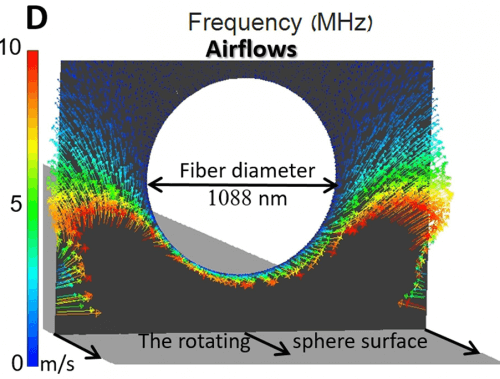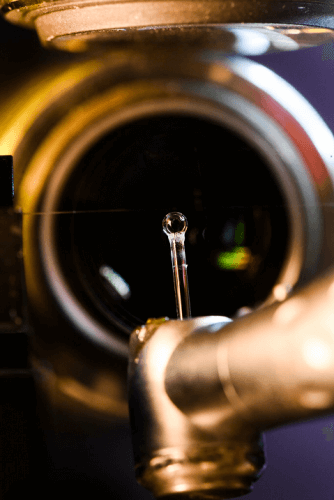The first optical isolator of its kind was developed by Prof. Tal Karmon from the Faculty of Mechanical Engineering at the Technion. The development was published in the journal Nature


Researchers at the Technion have built a first-of-its-kind optical isolator, based on the reverberation of light waves in a rapidly rotating glass sphere. This is the first photonic device where light moving in opposite directions moves at different speeds. The development was published in the prestigious journal Nature. The research was led by Prof. Tal Karmon from the Faculty of Mechanical Engineering and the Russell Berry Institute for Research in Nanotechnology at the Technion. According to him "we have developed here a very efficient photonic isolator that manages to isolate 99.6% of the light. This means that if we send 1,000 light particles, the device will correctly isolate 996 photons and miss only 4. Such isolation efficiency is required in quantum optical communication devices. The insulator we developed here fulfills several other essential requirements: it works well even when the light arrives simultaneously from both directions, it is compatible with standard optical fibers, it can be miniaturized and it does not change the color of the light."
Swimming down the river is faster than swimming up the river. Riding a bike with the wind at our back is faster than riding against the wind. It turns out that light also changes its speed as a result of a "back wind" or "swimming against the current", that is, as a result of the movement of the medium in which it moves. The speed of light is affected by the speed of the medium. Already in high school we learn that the speed of light is affected by the type of medium - the material in which the light moves. The speed of light in glass, for example, is slower than its speed in air. You also learn in high school that two light beams advancing in opposite directions through glass, or any other material, will advance at the same speed. "During my studies at the Technion I also learned that the speed of light depends on the speed of the medium in which it moves," says Prof. Carmon. "Just like the swimmer in the river, the speed of light against the motion of the medium is slower than its speed with the motion of the medium."
This phenomenon was already pointed out in 1849 by the French scientist Armand Fizeau. He showed that, similar to the speed of a swimmer in a stream, the speed of light downstream is faster than the speed of light upstream. Piso's discovery greatly influenced the development of special relativity by Albert Einstein. The drag exerted by the moving matter on the light, also called piezo-drag, may lead to significant applications in optics and computing. This is because the slowing down and speeding up of the light through the movement of the medium can produce an optical isolator - a device in which the incoming light from one side is absorbed and the incoming light from the other side passes through. Although the speed of light in the medium is the most basic property resulting from the interaction between light and matter, so far no photonic device has been built in which opposing beams of light advance at different speeds.
Now, for the first time, Technion researchers have succeeded in building an isolator based on different speeds of light for the beams advancing in opposite directions. It is a spherical optical device that rotates at high speed. Light beams are launched into the device from two opposite directions. The light coming from the right rotates around the circumference of the sphere with the direction of the sphere's rotation; The light coming from the left rotates against the direction of rotation and therefore moves at a lower speed. It can be said that the light is dragged along with the device.
The innovative device is an optical isolator - it transmits light coming from the left and turns off light coming from the right. According to Prof. Carmon, "the physical basis of the device, in addition to the drag applied to the light, is a resonator - a place where the light waves reverberate. The resonating light circulates inside the sphere thousands of times until it is absorbed. In contrast, non-resonant light passes through the device almost unhindered. In other words, the light moving with the device resonates and goes out, and the light moving against the device continues on without interruption."
The device was built in the glassblowing workshop at the Technion from a glass rod whose end was melted into a ball with a radius of one millimeter. The light source is a thin optical fiber, with a diameter one-hundredth of the thickness of a hair, which is a few nanometers away from the ball. The ball, which is the resonator, rotates at an enormous speed - the rim of the ball moves at a speed of about 300 km/h - and the light coming from the fiber rotates within it thousands of times. One of the engineering challenges faced by the research group was maintaining a constant minimum distance between the fiber (the light source) and the spherical resonator. "Maintaining an accurate distance is a complicated challenge even if the device is not moving, and it is a much more complicated challenge when it comes to a ball that is spinning at an enormous speed. Therefore we looked for a way to force the fiber to move with the ball despite the fact that the fiber and the ball are not connected. Eventually we found a way to do it: the fiber floats on the wind that creates the spin of the ball. Thus, if the device vibrates - and because of the rapid rotation it inevitably vibrates - the fiber will vibrate together with the rotating ball and the distance between them will be maintained."
According to Prof. Carmon, "We hope that we have paved the way for a new type of opto-mechanical devices based on characteristic forces for nanometer distances. The forces operating at these distances are Casimir forces and van der Waals forces - very strong forces, originating from quantum effects, which until now have hardly been used in mechanical devices in general and resonators in particular. We recently demonstrated for the first time a new type of laser in which water waves cause the emission of light; We also demonstrated, for the first time, a micro laser in which an acoustic wave causes the emission of light. It is possible that in the future we will be able to create lasers based on Casimir forces and van der Waals forces in the new resonators."
The research was led by Prof. Carmon with his research group and their partners at the College of Optics and Photonics (CREOL). The experiment was conducted by Rafi Dahan, who was then a master's degree student, and the doctoral student Shai Ma'ini. Dr. Ma'aini is currently in a post-doctorate at MIT, where he is developing innovative optical fibers under the guidance of Technion graduate Prof. Yoel Fink. Dr. Maaini chose this field of research, which was defined as a strategic need for Israel, out of a desire to return to Israel as a faculty member at the end of his post-doctorate. Prof. Carmon emphasizes that the first five authors of the article are members of the Faculty of Mechanical Engineering at the Technion, including Yuri Kaligerman and Edward Moses, who performed the calculations.
The study was supported by the I-CORE Center of Excellence, the "Circle of Light" and the Ministry of Science and Technology.

2 תגובות
https://sci-hub.se/10.1038/s41586-018-0245-5
The claim that the speed of light is constant and absolute was challenged by the aether theory which proposed that the aether (the medium in which space supposedly exists) creates an inhibitory interaction with waves or particles moving through it.
This is an experiment with a bizarre result that is counterintuitive, and it again raises the question of whether the definition of space exists within a medium.